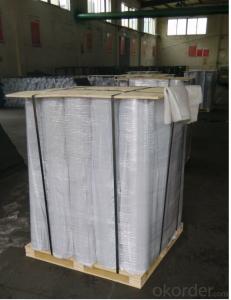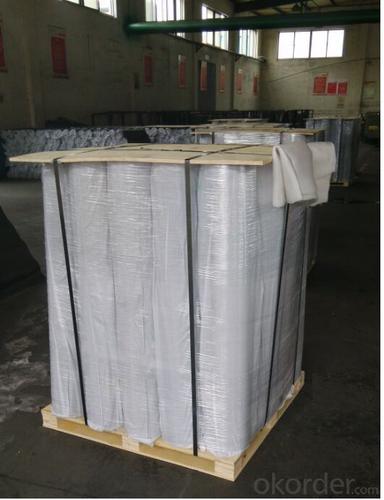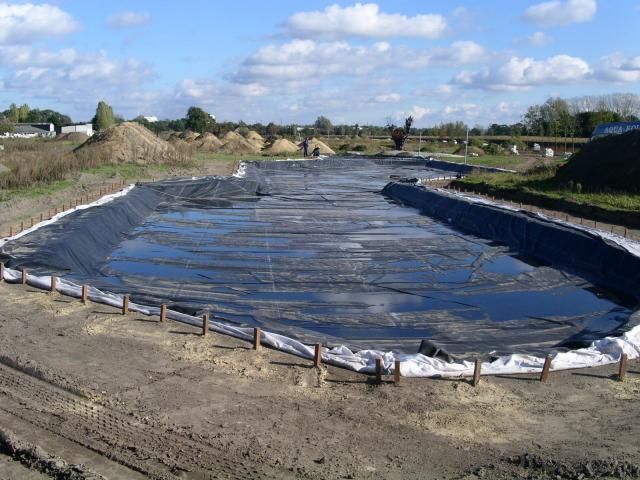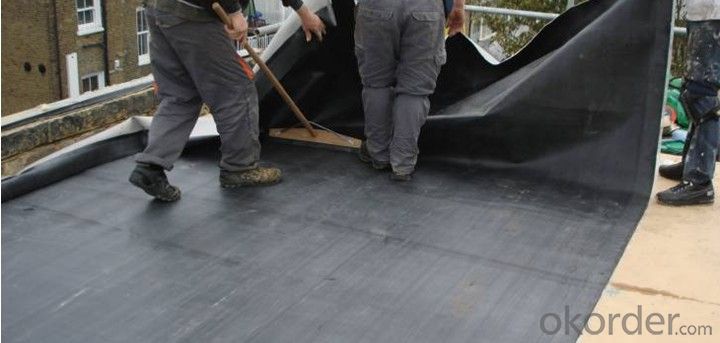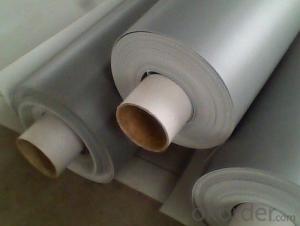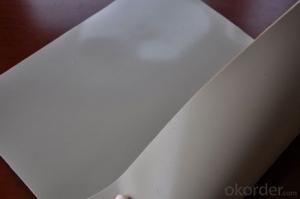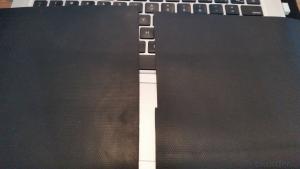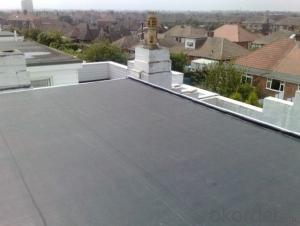EPDM Rubber Coiled Waterproof Membrane for Pallet Packing
- Loading Port:
- Shanghai
- Payment Terms:
- TT OR LC
- Min Order Qty:
- 50000 m²
- Supply Capability:
- 5000000 m²/month
OKorder Service Pledge
OKorder Financial Service
You Might Also Like
EPDM Rubber Coiled Waterproof Membrane for Pallet Packing
Description Of EPDM Rubber Coiled Waterproof Membrane for Pallet Packing:
•EPDM waterproof sheet has excellent anti-ozone-aging performance, able to resist ultraviolet light and corrosion of many chemical corrosive materials in the atmosphere
•It has high tensile strength, high ductility and strong retractility, it has excellent crack resistance, able to effect waterproof function even with tiny vibration of buildings.
• Excellent resistance to ozone, oxidation and sunlight.
• Resistance to chemicals; resistant to most inorganic products.
Main Features of EPDM Rubber Coiled Waterproof Membrane for Pallet Packing:
1>Excellent antiaging performance, service life up to 50 years
2>Working well with in 40C to 100C,it canbe constructed with a single layer in ambient temperature.
3>Waterproofing on various kinds of underground project,industrial of civil buildings and structures.
4>high extension rate, high tensile strength, small size changes at heat treatment
5>Good plant roots penetrability resistance and can be made waterproofing layer of planting roof
6>Special modified molecular structure ,effectively resolving the current domestic and foreign glue joint problem.
7>Good low temperature flexibility, and good performance of adapting to ambient temperature changes.
8>Convenient application ,solid joint, no environment pollution
9>chemical corrosion Resistance, can be used for special occasions
10>Convenient maitenance, low cost.
Specifications of EPDM Rubber Coiled Waterproof Membrane for Pallet Packing:
| Material | EPDM Rubber |
| Size | 1.2m (width)*20m (length) or customized, weldable type 2.05m or 4m width |
| Thick | 1.2mm, 1.5mm, 2.0mm |
| Type | Vulcanized & Weldable |
| Pattern | Non-reinforced (homogeneous) |
| Certificate | ISO9001/14001 |
Applications of EPDM Rubber Coiled Waterproof Membrane for Pallet Packing:
Widely used in roofs, basement, toilet ,swimming pool, and all kinds of industry and civil building waterproofing, reservoir, vivicism, bridge, underground, tunnel and dam waterproofing ,especially to the keystone waterproofing projects which is durability, high corrosion resistance and easy deformation.



IMages of EPDM Rubber Coiled Waterproof Membrane for Pallet Packing:




FAQ of EPDM Rubber Coiled Waterproof Membrane for Pallet Packing:
1. What are we supplying?
We are specialized in producing Colorful Asphalt Roof Shingle, SBS/APP modified bitumen waterproof membrane, Self adhesive bitumen waterproof membrane, PVC waterproofing membrane, EPDM rubber roofing membrane, Single Component Polyurethane Waterproof Coating, and Spray Polyurea Waterproof Coating
.
2. How Many years experience do we have?
We have been exported to more than 20 countries in the past 15 years.
3. How long do we usually reply your request?
We always reply our customer within 24 hours.
- Q: Can waterproofing membranes be painted over?
- Painting over a waterproofing membrane is indeed possible. Nevertheless, it is crucial to verify the compatibility between the paint and the membrane material. It is advisable to refer to the manufacturer's guidelines or seek expert advice in order to guarantee the paint adheres well and lasts long. Furthermore, prior to applying the paint, the surface must be clean and dry to achieve optimal outcomes. All in all, painting over a waterproofing membrane can improve its aesthetic and offer extra safeguard against UV rays and other environmental elements.
- Q: Can a waterproofing membrane be used in chemical or hazardous environments?
- Yes, a waterproofing membrane can be used in chemical or hazardous environments. Waterproofing membranes are designed to provide a protective barrier against water and moisture, and some specialized membranes are also resistant to chemicals and hazardous substances. These membranes are commonly used in industries such as manufacturing, chemical processing, and wastewater treatment plants to prevent leaks and protect against corrosion caused by chemicals. However, it is essential to select a membrane specifically designed for the particular chemicals and hazards present in the environment to ensure optimal performance and safety.
- Q: Can a waterproofing membrane be used in permanent or long-term structures?
- Yes, a waterproofing membrane can be used in permanent or long-term structures. Waterproofing membranes are designed to provide durable and long-lasting protection against water intrusion. They are commonly used in various construction applications such as basements, roofs, foundations, and underground structures to prevent water damage and leakage. These membranes are engineered to withstand the test of time and can effectively extend the lifespan of a structure by ensuring its integrity and preventing moisture-related issues.
- Q: Can a waterproofing membrane be used on adobe block surfaces?
- Yes, a waterproofing membrane can be used on adobe block surfaces. Waterproofing membranes are commonly used to provide an additional barrier against water penetration and moisture damage, and they can be applied to various surfaces, including adobe blocks, to enhance their water resistance and durability.
- Q: Can a waterproofing membrane be painted or covered with a protective layer?
- Yes, a waterproofing membrane can be painted or covered with a protective layer. However, it is important to choose the right type of paint or protective layer that is specifically designed for use with waterproofing membranes. This ensures that the integrity of the membrane is not compromised and that it continues to provide effective protection against water damage. It is also important to follow the manufacturer's guidelines and recommendations when applying paint or a protective layer to the membrane. This may include proper surface preparation, application techniques, and maintenance instructions. By following these guidelines, the waterproofing membrane can be painted or covered with a protective layer without compromising its effectiveness.
- Q: Can a waterproofing membrane be used for underground utility tunnels?
- Yes, a waterproofing membrane can be used for underground utility tunnels. A waterproofing membrane is a thin layer of material that is applied to the surface of a structure to prevent the penetration of water or moisture. It is commonly used in construction to protect buildings and structures from water damage. In the case of underground utility tunnels, where there is a high risk of water infiltration due to the surrounding soil and groundwater, a waterproofing membrane can be extremely beneficial. It can provide an effective barrier against water, preventing it from entering the tunnel and causing damage to the utilities inside. There are various types of waterproofing membranes available, including sheet membranes, liquid membranes, and spray-applied membranes. These membranes are typically made from materials such as asphalt, modified bitumen, polyurethane, or rubberized asphalt. They are designed to be durable, flexible, and resistant to water and other environmental factors. Before applying a waterproofing membrane to an underground utility tunnel, proper surface preparation is essential. The surface should be cleaned, free of any debris, and in good condition. The membrane should then be installed according to the manufacturer's instructions, ensuring that all seams and joints are properly sealed to create a continuous waterproofing barrier. It is important to note that waterproofing membranes are not a standalone solution for underground utility tunnels. They should be used in conjunction with other waterproofing measures, such as proper drainage systems, to ensure comprehensive water protection. Regular inspection and maintenance of the membrane are also necessary to check for any damage or deterioration and to address any issues promptly. In conclusion, a waterproofing membrane can be an effective solution for protecting underground utility tunnels from water infiltration. By creating a strong and durable barrier against moisture, it helps to maintain the integrity of the utilities and prolong the lifespan of the tunnel infrastructure.
- Q: Can a waterproofing membrane be used for a retaining wall drainage?
- Using a waterproofing membrane is an effective method for retaining wall drainage. Typically used to prevent water from penetrating structures like basements or foundations, this membrane can also serve as a barrier against water seepage in retaining wall construction. Retaining walls are designed to hold back soil and prevent erosion, but without proper construction, they can be vulnerable to water damage. If water seeps through, it can create pressure behind the wall, causing structural problems over time. By installing a waterproofing membrane on the backside of the retaining wall, water infiltration into the soil and accumulation behind the wall can be prevented. Furthermore, a waterproofing membrane can help with the drainage of water away from the retaining wall. By incorporating drainage systems like weep holes or French drains, alongside the membrane, water can be directed away from the wall, reducing hydrostatic pressure and potential damage. It's important to note that while a waterproofing membrane can be used for retaining wall drainage, proper installation and compatibility with the specific retaining wall system and conditions are crucial. It's recommended to consult with a professional engineer or contractor experienced in retaining wall construction to ensure the most suitable approach for your specific project.
- Q: Are waterproofing membranes resistant to acid exposure?
- Yes, waterproofing membranes are generally resistant to acid exposure. They are designed to provide a barrier against water and other corrosive substances, including acids. However, the level of resistance may vary depending on the specific type and quality of the membrane used.
- Q: Are waterproofing membranes UV resistant?
- Yes, waterproofing membranes are typically UV resistant. They are designed to withstand exposure to sunlight without degrading or losing their effectiveness. This UV resistance helps to prolong the lifespan of the membrane and maintain its waterproofing properties over time.
- Q: Can a waterproofing membrane be used on tunnels with emergency exits?
- Certainly! Waterproofing membranes can be applied to tunnels that have emergency exits. It is strongly advised to utilize a waterproofing membrane in these tunnels to prevent water infiltration and safeguard the integrity of the exits. These membranes are specifically designed to establish a barrier against water and moisture, guaranteeing that the tunnels stay dry and unharmed by water. This is particularly crucial for emergency exits, as they must remain accessible and operational under all circumstances. By installing a waterproofing membrane, the tunnels can be adequately shielded from potential water ingress, thus ensuring the safety and functionality of the emergency exits.
Send your message to us
EPDM Rubber Coiled Waterproof Membrane for Pallet Packing
- Loading Port:
- Shanghai
- Payment Terms:
- TT OR LC
- Min Order Qty:
- 50000 m²
- Supply Capability:
- 5000000 m²/month
OKorder Service Pledge
OKorder Financial Service
Similar products
Hot products
Hot Searches
Related keywords
